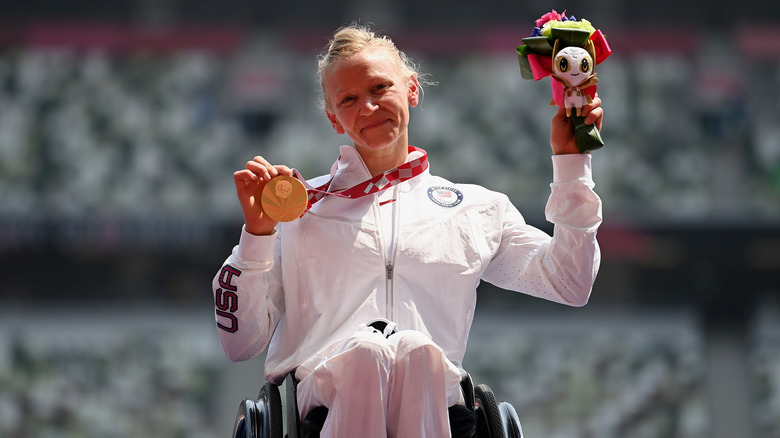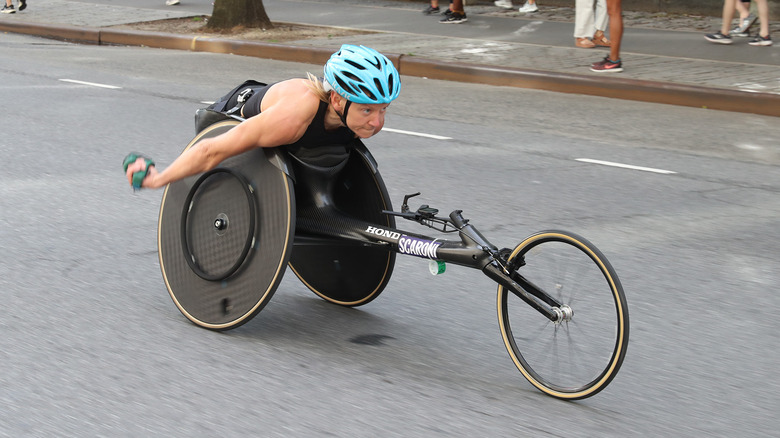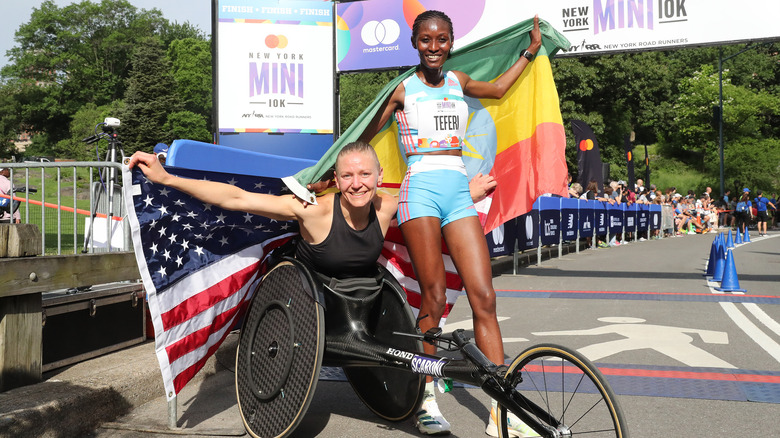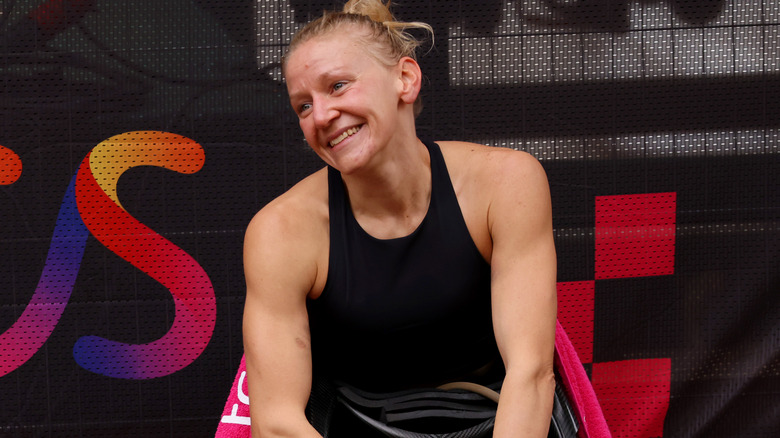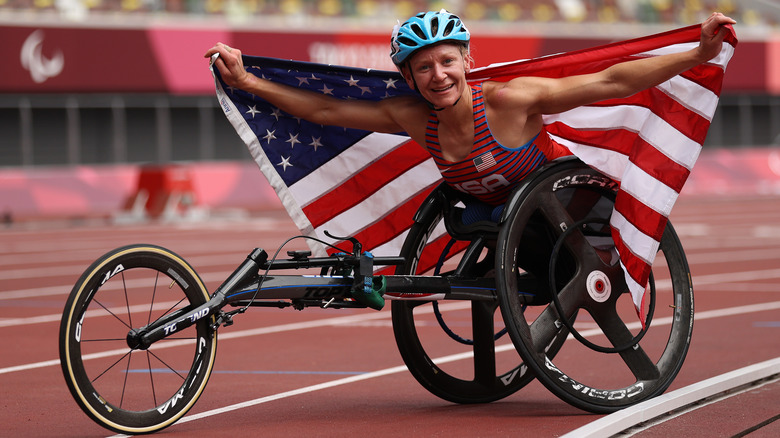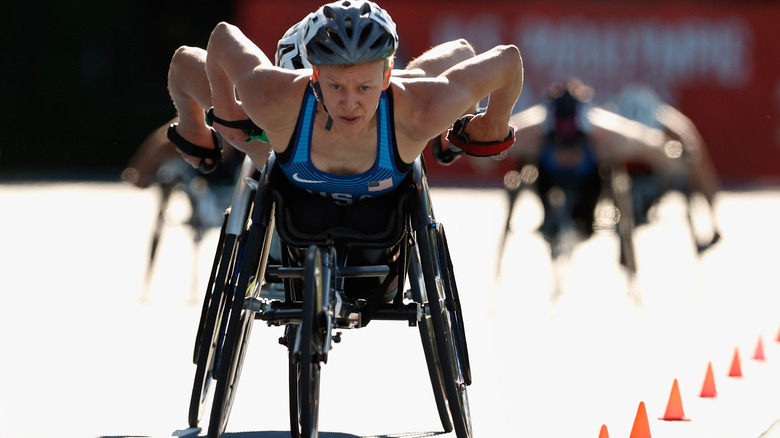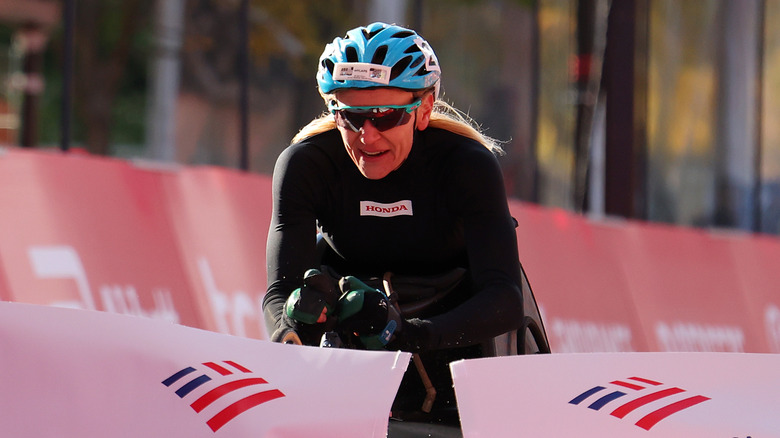Paralympic Gold Medalist Susannah Scaroni Recounts Her Incredible Journey - Exclusive Interview
Paralympian Susannah Scaroni is nothing short of inspiring. She became paralyzed from the waist down at age 5 and continued to live an active lifestyle, pursuing her athletic passion. In the 2020 Paralympics in Tokyo, her ambition paid off, and she won both the gold and bronze medals. Tragically, that year in September 2021, she collided with a car while training on the roads in Illinois, suffering a fracture in her vertebrae that halted her from competing for the rest of the year. But that didn't stop her.
This year, Scaroni is back, and she is breaking records every chance she can get. In June, she won her fourth Mini 10K in a world-best time and broke the 5,000-meter world record. Then, in the past several weeks, she hit the top-3 three weeks in a row: She won first place in the Chicago Marathon, second at the London Marathon, and third in Berlin (via New York Times).
Coming up in November 2022, Scaroni will compete in the TCS New York City Marathon for the first time since 2019, where she has raced many times before but hasn't finished first — yet. In an exclusive interview with Health Digest, Susannah Scaroni shared about her journey to the Paralympics, what she loves about competing, her training nutrition plan, and advice on how to reach your athletic goals.
Where it all began
Can you explain to us a little bit more about your background and how you got involved in the Paralympics?
I am 31 now. I grew up in a small community in eastern Washington State, south of Spokane. There were like 800 people in my town. When I was 5, my mom, my brother, and I were in a car accident. We slipped on ice into oncoming traffic. I had taken the shoulder [seatbelt] strap off and just had the belt strap on because it was rubbing on my neck — this was before booster seats were widely used — so I fell forward really quickly and snapped my spinal cord.
I was 5 at the time. That's super important because I was in kindergarten, and when I got to start going back to school, I was basically treated exactly like everybody else. I was the only person in a wheelchair, so there wasn't a group to segregate me to be with.
I got to learn how to be creative about how to play the game or whatever we were doing and become independent pretty quickly. If we were going to tumble down the hill in recess, I had to be able to get back in my wheelchair and those kinds of things.
I existed that way, and ... I've told people this before. I don't think I even could tell I was in a wheelchair until I was in third grade, when everybody gets to play basketball at that grade. I also played basketball, but that's when I learned I was slower than everybody else. Because of that, it was a rule every game that people had to pass me the ball at least once before we could shoot a basket and those kinds of things. I hated that feeling; I felt very patronized. Even though I understand the intent and the will behind it, I was like, "I'm never doing that again."
A year later, my family learned about an expo day of all different kinds of adaptive sports that were in Spokane. We went to that, and it was super fun. I got to try rock climbing, wheelchair tennis, and wheelchair basketball. The basketball team said, "Hey, can you guys come to our basketball practices? They're every weekend, Fridays." I was like, "Definitely don't want to go. That would be terrible." But my mom said I had to go.
In fourth grade, I went to my first wheelchair basketball practice. That day, I was given everything I had hoped for the year before. I was literally playing basketball and nothing else mattered. I was also lucky, because a lot of the other kids were my same age when I started, so I had immediate friends that I made. I loved everything about it — I had a supportive family that would drive me up an hour every week.
Working out with a wheelchair
Susannah Scaroni (continued): That spring, they said that track practice was going to start. I had no idea what wheelchair track was going to be like, but I asked my mom if I could go, and she took me again. We were going up twice a week for different practices — I loved it. I was also built pretty nicely for wheelchair racing. When you're injured at the age of 5, your legs are atrophied, so you can fit tightly into a racing chair. I've got pretty long arms, so I was able to do pretty well at both of those sports. I loved them and continued racing and playing basketball all the way through high school.
I was planning to come to the University of Illinois because there were two programs that had wheelchair racing at the time, Arizona and Illinois. But Illinois had so many successful athletes come out of it that it was my primary school option. I got in, but the out-of-state tuition was so expensive that my mom said I couldn't go.
Instead, I went to a private school in Helena, Montana, for college. I was a chemistry and health science major. When I was there, I was again the only person who used a wheelchair. I didn't have any major ambitions in terms of sporting competitions, but I've always loved doing the sports and training and exercising.
I had my racing chair with me and I would go push out on my own. I would swim a mile at the pool, or I would use the weight room that the football players used, because there was no elevator to get up to where the students would exercise. I was going about my life and doing all these things on my own.
There's a local road race in Spokane, so when I went home for the summer break, I would do that. The coach at Illinois called me my sophomore year and said, "Hey, Susannah, I know you were at Bloomsday last year. I don't know what your plans are, but if you're interested, we now have an opportunity to provide all of the out-of-state tuition. There's an internal scholarship that would pay for it if you'd like to come to Illinois."
I was shocked at that point. I talked to my friends and I was like, "I don't know what I should do." They were like, "You train all the time, why would you not go? This way, you can be with a real team."
At that point, I wrote essays as quickly as I could and got in, so I transferred to Illinois in 2011. That was my first time being on a formal team that trained every day. I'd already gone through a lot of hard classes, so it was also my third year of getting to take some lighter loads of classes and having this opportunity to have very organized training. That made such a great connection. Already, I had a love of exercising on my own. Without any goal at hand, I love doing it.
Thankful to be alive
Susannah Scaroni (continued): I did my first marathon in 2011, in October, in Chicago. That time qualified me for Boston, so in April, I did Boston. My coach looked at that time and said, "Susannah, I think you should do Grandma's Marathon in June of this year." I was excited. I was like, "That sounds great. I love marathons."
It was actually Grandma's that qualified me for the 2012 Paralympic Games in London. I don't think anybody saw it coming. My coach knew I was on the track of having some quick times, but it was a complete shock. At that point, when you make the Paralympic Games, the marathon series directors see your name. That was the point that I started getting invited to things.
I was invited to New York City for the first time in 2012, and then London. I mistakenly started my Paralympic journey there, with this love of getting to push my best. The guidance that I've gotten at Illinois, from our coach, and from all of the amazing athletes here, and the support of my university, my classes, and my research group — it's all worked nicely for me to continue to improve.
I'm a really slow learner. But now, after 11 years here, I'm starting to get a little more speed, and it's been a great journey.
I heard about your accident that happened last year — I'm so sorry about that, but also glad to hear you made a full recovery. How does it feel not only to be back but also to have just won the Chicago marathon, marking your third marathon win in the last three weeks?
Thank you. It feels great. I've said this before, that after September ... I'm already thankful to be alive. But it's a different experience. I can still remember the crash, and I'm so thankful that I survived. It really has changed my perspective when I'm at a race, because I feel almost like I was given this chance to be here again. It highlights the role that we have as athletes, and as people with disabilities, to represent what you can do and that you can always go after what you want to do. I cherish the ability to do that.
I'm so thankful that I've gotten to recover successfully and that I keep getting that opportunity to be a role model. That's what's changed when I'm racing now — it's almost like, "Wow. There's a reason I'm supposed to be here still." I'm really thankful for that opportunity.
Pushing yourself to do your best
What's your favorite part about competing?
My favorite part is definitely getting to push my limits. That's all I ever try to do when I'm racing, is pick a speed that's hard to hold and see if I can make it feel a little bit easier as I'm going along. I love that.
I'm probably one of the only people that loves that, but it's something that gives me a lot of personal joy. I don't love being in a draft with other athletes. That's a great strategy to come across first, but I'm the person that would rather be a pacer, like, "I'll be up here pushing us, if you guys want that more."
I'm thankful that right now, I've been able to create a gap with some athletes. I was able to create a gap in Chicago, so I got to do what I wanted to do, which is go at my pace that I wanted to go at, and I still got to win.
It's not a great strategy. I would never teach an athlete that that's what you should do. But it's what brings me the most joy, because I know what I'm doing is the best I can do.
I've noticed that you're very passionate about sports nutrition and diet. What got you interested in those topics?
When I was in ninth grade, I had an eating disorder. Now that I know so much more about nutrition, "relative energy deficiency in sport" (RED-S) is what we now call it. It's this triad of exercising a lot, not eating very much, and then, for a female, losing your menstrual cycle. Those are some key elements of it.
I remember believing that I needed to be smaller to be faster. It started in eighth grade — I remember that spring of eighth grade trying to get into my racing chair, and I did not fit in anymore. That's what triggered it. Now, as a 31-year-old, I'm like, "Man, where were the people saying, 'No, you're in eighth grade. Girl, you're growing. You just need a bigger race chair'?"
I had to learn the hard way, as I pretty much always do, that when I did start eating enough — which was after being on bed rest for a year and missing the Beijing trials — I started to get stronger and faster. I could not believe that; I remember being so shocked.
At that point, I was really invested in what the role of nutrition is and different macronutrients for athletes. It's led me down this path [where] there are so many intricacies, and there's different sports with different needs. Exercise metabolism is so cool, and that's why I'm still passionate about it.
If you need help with an eating disorder, or know someone who does, help is available. Visit the National Eating Disorders Association website or contact NEDA's Live Helpline at 1-800-931-2237. You can also receive 24/7 Crisis Support via text (send NEDA to 741-741).
Training diet plan
What is your current diet like these days?
My current diet is pretty high in carbohydrates while also making sure I dose in 15 to 20 grams of protein four times a day, in addition to having colorful things in your diet. I'm definitely a foodie. Those are the frameworks that I work within, and then I add a ton of variety into it.
I'm a big fan of eating everything in one big bowl. People who separate their food, I could never do that, because I'm so into textures that I have to combine a million things together to enjoy it. [That] dreads a lot of people around me; they're disgusted sometimes by what I eat. I am that person that eats everything in a big bowl.
Do you have specific foods you gravitate toward while training?
It's been a process to learn what I like the most. At the moment, I'm big on having a Cliff Bar before a marathon, [and] ideally, a tall coffee with two shots of espresso. Also, I have a lot of coffee in the morning. I pretty much stop at around 11, but I have a lot of coffee before that.
At a marathon, I'll have a Cliff Bar, a banana, and caffeine. At home, depending on how long the workout is, I'll do a similar thing — maybe a Cliff Bar or a bowl of cereal. I like to combine cereals too, because one cereal gets a little boring, so I pretty much always have two kinds of cereals, a small amount with dairy milk. I usually have two double espressos before practice.
Those are my before-workouts. I always try to get high carbohydrates with low fiber. After practice, I aim for about 20 grams of protein with 40 grams of carbohydrates, which is normally Greek yogurt mixed with berries and spinach, and some granola on top of that. The rest of my day, [I'm] making sure there's protein in every meal and carbohydrates, and staying hydrated.
Make small, accessible goals for yourself
Do you often carbo-load before a competition, and do you have a favorite carbo-load meal?
I don't carbo-load per se — I routinely have a decent amount of carbohydrate availability. We train six days a week, and our sport is predominantly intermittent high intensity, so there's a lot of accelerations that go on in our sport. I try to always have enough carbohydrates to get my intensity up high.
One of my favorite meals to do that, [which] I also do before a race, [is] ramen. I had ramen before Chicago. I love pasta and sweet potatoes. I also love bibimbap from a Korean restaurant. I would probably be willing to eat bibimbap before a race with rice.
If I'm going to have ramen, I want to make sure I have it early enough in case it's extra salty or something so that I'm not dehydrating myself. It worked out well in Chicago. It was some good ramen.
Your strength and motivation are truly inspiring. Do you have any advice for people who want to be more athletic but struggle with how to get there?
Having small goals for yourself is really important. Have a goal. The goal is "be more active," but breaking that into smaller chunks is the way to be successful.
You want to be more athletic, but maybe that means you want to walk at a brisk pace for two whole minutes, and then take a minute off, and then two more whole minutes on your morning walk. Break it up into small chunks and build off of those.
Having too many goals all at once can be disheartening. If you need to change what you're eating, or what time you're getting up and how active you are, that can be a little disheartening sometimes. Starting off simple with one thing at a time is [how to be] successful.
When you're not busy training, what do you like to do in your free time?
I love reading. It's one of my favorite things; I love reading fantasy. I also love going out on walks. My husband and I have a Blue Heeler dog who loves playing outside. We go on walks together — I love being outside.
And cooking — I love cooking and eating. Those are probably my three hobbies. Going on walks, cooking and eating, and reading.
Watch live coverage of Susannah Scaroni at the TCS New York City Marathon on November 6 from 8:30–11:30 a.m. ET on ESPN2 and via the ESPN App.
This interview was edited for clarity.

